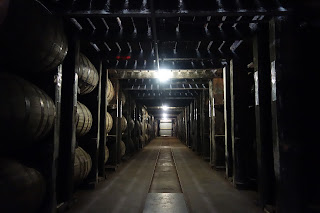 There was a horse at Keeneland yesterday named Bourbon Happens - I noticed he came in dead last in his race; perhaps he'd stopped at the Buffalo Trace Distillery in Frankfort on his way to the track.
There was a horse at Keeneland yesterday named Bourbon Happens - I noticed he came in dead last in his race; perhaps he'd stopped at the Buffalo Trace Distillery in Frankfort on his way to the track.There has been a distillery in continuous operation at the site of what is now Buffalo Trace for 240 years. Even during Prohibition, there was special dispensation for some distilleries to operate in order to produce spirits for "medicinal purposes." Our tour-guide, Art, told us that most illnesses were "chronic" in those days, and actual prescriptions were continually written for whiskey throughout the thirteen years when alcohol was prohibited.
I knew there was a difference between whiskey and bourbon but I thought it was a "champagne" thing - that only Kentucky could produce bourbon, but that's not actually the distinction. And although 95% of the country's bourbon is made in Kentucky, what makes the difference is simply a matter of ratios: bourbon, by law, has to be made from at least 51% corn. The other ingredients include rye and barley but it's the amount of corn that determines if whiskey is bourbon. We also learned about the history of bourbon, from the original makers who were the Scots-Irish to the Whiskey Rebellion of 1791 (taxes... it's always about taxes), which George Washington put a quick end to, and which precipitated the movement of the Scots-Irish from Pennsylvania to the area that would become Kentucky. We also learned that the discovery that barrel aging enhances flavor was one of serendipity -- after the Scots-Irish whiskey makers moved to KY, they realized it was easier to get the product south to New Orleans through the waterways than to get it to the north over the Appalachian Mountains; it took a year to get the barrels to their destination, and when it became clear that the bourbon that showed up in New Orleans was far superior to the bourbon that left the distillery in what is now Frankfort, barrel-aging became part of the process. Buffalo Trace ages its Eagle Rare label for 10 to 12 years; the more basic Buffalo Trace Straight ages for 8 to 9 years, and the White Dog is essentially moonshine, sold straight from the still; it's clear, and 62% alcohol. It was offered at the tasting at the end of the tour Jen and I took today, and neither of us were remotely interested in taking a sip.
 What we did try was the Eagle Rare and the Straight, along with the Bourbon Cream, which is essentially dessert in a glass - made with actual cream, which right there makes it far superior to Baileys, which needs no refrigeration, something of which I've always been suspect.
What we did try was the Eagle Rare and the Straight, along with the Bourbon Cream, which is essentially dessert in a glass - made with actual cream, which right there makes it far superior to Baileys, which needs no refrigeration, something of which I've always been suspect.

As mentioned in yesterday's post, I've never really enjoyed gambling - yet yesterday at the track: so much fun. I've also always been a confirmed hater of whiskey - yet today at the distillery: thoroughly enjoyed my small tastes of the amber liquid. I'll never switch to bourbon cocktails, but if offered... if in just the right mood... I could see myself having a dram on a cold night. I could definitely see myself pouring someathat Bourbon Cream on a bowl of ice cream, that's for damn sure. Lesson for the week: Never say 'never' in Kentucky.
 |
| horse pastures in Woodford County |


